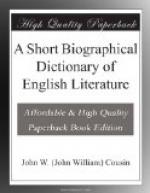the prototype of Blumine in Sartor.
Returning in 1819 to Edin. he for a time studied law
and took pupils; but his health was bad, he suffered
from insomnia and dyspepsia, and he tired of law.
He was also sorely bestead by mental and spiritual
conflicts, which came to a crisis in Leith Walk in
June 1821 in a sudden uprising of defiance to the
devil and all his works, upon which the clouds lifted.
For the next two years, 1822-24, he acted as tutor
to Charles Buller (whose promising political career
was cut short by his premature death) and his brother.
On the termination of this engagement he decided upon
a literary career, which he began by contributing
articles to the Edinburgh Encyclopaedia.
In 1824 he translated Legendre’s Geometry
(to which he prefixed an essay on Proportion), and
Goethe’s Wilhelm Meister; he also wrote
for the London Magazine a Life of Schiller.
About this time he visited Paris and London, where
he met Hazlitt, Campbell, Coleridge, and others.
Thereafter he returned to Dumfriesshire. In the
following year (1826) he m. Jane Baillie Welsh,
and settled in Edin. Here his first work was
Specimens of German Romance (4 vols.) A much
more important matter was his friendship with Jeffrey
and his connection with the Edinburgh Review,
in which appeared, among others, his essays on Richter,
Burns, Characteristics, and German
Poetry. In 1828 C. applied unsuccessfully
for the Chair of Moral Philosophy in St. Andrews,
and the same year he went to Craigenputtock, a small
property in Dumfriesshire belonging to Mrs. C., where
they remained for several years, and where many of
his best essays and Sartor Resartus were written,
and where his correspondence with Goethe began.
In 1831 he went to London to find a publisher for
Sartor, but was unsuccessful, and it did not
appear in book form until 1838, after having come out
in Fraser’s Magazine in 1833-34.
The year last mentioned found him finally in London,
settled in Cheyne Row, Chelsea, his abode for the rest
of his life. He immediately set to work on his
French Revolution. While it was in progress
he in 1835 lent the MS. to J.S. Mill, by whose
servant nearly the whole of the first vol. was burned,
in spite of which misfortune the work was ready for
publication in 1837. Its originality, brilliance,
and vividness took the world by storm, and his reputation
as one of the foremost men of letters in the country
was at once and finally established. In the same
year he appeared as a public lecturer, and delivered
four courses on German Literature, Periods
of European Culture, Revolutions of Modern
Europe, and Heroes and Hero-Worship, the
last of which was pub. as a book in 1841.
Although his writings did not yet produce a large
income, his circumstances had become comfortable,
owing to Mrs. C. having succeeded to her patrimony




